Why the market is tanking and what are we doing?
Published 11-JUN-2022 09:52 A.M.
|
19 minute read
It’s been a horror week for small cap stocks, following a pretty rough couple of months.
Here’s what we think is happening:
- The small cap market was hot in the early part of 2022 - most stuff was going up.
- Short term investors bought at higher prices chasing the momentum of hot stocks.
- Long term investors locked in some capital gains.
- “Sell in May and go away” came along...
- A global market correction deepened the sell off.
Now in June, some long term investors sitting on capital gains are likely selling some of their paper loss positions to offset their capital gain tax bill.
This is combined with short term investors who are also likely selling underwater positions to offset future capital gains they expect to make.
While there are many sellers, there are NOT many buyers, given the broader market sentiment.
So even small amounts of selling can move down the share prices of good small cap companies.
Which then encourages MORE tax loss selling - compounding the downward price moves...
Many small cap stocks (including our Portfolio stocks) have taken a downward hit on relatively small volume in June.
And to put the boot into an already rougher than usual “sell in May and go away” and “tax loss selling June”...
The Reserve Bank lobbed in a bigger-than-expected 0.5% interest rate rise.
AND threatened a similar one next month.
So like clockwork every year, “sell in May” and “tax loss selling June” have been doing their thing.
Except this year the pain has been exacerbated by a global market correction...
AND a bigger than expected rate rise.
So what are we doing when the small cap market is crashing?
Same thing we did when it crashed in March 2020.
Holding on and waiting for the fear to pass, plus looking to make some new Investments while valuations are down.
Reminder: This is NOT financial advice, this is just what we are doing and what works for us.
Our best results have come from holding longer term, in a popular macro theme, and patiently waiting for re-rates as the companies deliver on key objectives over time.
We have also observed (for our situation) there is no point selling our small cap stocks during “peak fear and uncertainty”.
Small cap stocks fluctuate wildly up OR down over time for a wide variety of reasons.
The true valuation of a small cap stock is found in its long term average share price over a couple of years.
We hold positions for the long term with a pre-planned de-risking strategy (shared in our Investment memos).
While the small cap space is consistently pretty rough this time of year, we don’t employ any specific strategy around the usual May and June weakness.
...except maybe some tax loss selling if one of our shorter term positions is significantly underwater (looking at you PRM and GLV... both down ~80% this week).
In May we sold down a total of just 2.9% of our Total Portfolio (as part of pre-set investment plans across several stocks, not because of the “sell in May” mantra).
In June we expect to do zero selling where we are showing paper losses on long term positions that we believe in.
In general, we are intentionally NOT active sellers during May and June, as much as it pains us in April knowing the paper value of our Portfolio value is likely to take a decent hit for a couple of months.
This is because as long term holders, the capital gains discount for holding a position for over 12 months is more valuable to us than trying to exit holdings when some of our long term positions are taking a (hopefully) temporary hit on paper.
Generally, we try to ride it out until the market, hopefully, bounces back in July like it does most years and discover the true value of each stock over the long term.
This is our personal strategy and certainly not investment advice. Everyone needs a strategy that works for their financial situation, risk profile and ability to emotionally withstand seeing paper losses.
The silver lining on this rough patch in the small cap market
There are perfectly good stocks — with plenty of cash in the bank that have not changed or done anything wrong — but are getting pushed down this month due to a group of investors' personal strategies (tax selling) and general market sentiment.
Our best longer term returns have come from Investments we made in 2020 when the market was annihilated during the uncertainty in the early days of Covid.
Everybody hated the market and especially hated small caps - great companies were cheaply priced compared to when the market had been running hot or was even just OK.
Long term readers will have noticed our most active year of adding new companies to our Portfolios was during 2020 when valuations were low and small caps unloved, many of which are still trading above entry price today.
We added 19 new companies across our Portfolios in 2020.
As the market started heating up in 2021, company valuations started rising across the board.
Good value was harder to find - we made a similar amount of new Portfolio additions that year, but found that the higher valuations across all small caps made it harder to show increased returns.
During the first half of 2022 valuations continued to be high in a buoyant market, and we have only made 8 new Portfolio additions so far.
In 2022 the best value we found was investing in well priced IPOs, hence 3 out of our 8 new Portfolio additions in 2022 were IPOs, compared to just one IPO in the previous two years.
We are going to try and take a lesson from these last 3 years.
Now that the small cap market is looking well and truly rough again, and decent stocks are coming back to good buying value (in our opinion), we will likely accelerate the number of new Portfolio additions we make in the medium term.
Given the past success of the Portfolio additions we made during 2020 when the market was awful, this seems like the right approach.
These new Portfolio additions will be Investments we plan to hold over the long term, into the next market run.
But looking at today’s painful Portfolio paper losses, a buoyant market feels like an eternity away.
Our experience tells us the market has always come back in the past - it’s just a question of how long it will take.
We will also look to increase positions in some of our highest potential portfolio companies that have a strong cash balance and have shown us they can consistently execute on the objectives we set for them in our Investment memos.
Soon we will share the key sectors and company types we will be looking to Invest in over the next 12 months.
Here is a sneak peek - during the current small cap downturn we will focus on new Investments in:
Current popular macro themes where valuations have now become attractive again:
- Battery metals and critical metals
- Energy (gas)
- Green energy
- Food tech and food security
Currently unloved macro themes we think will shine again in the medium term:
- Precious metals
- Biotechs in general
- Medicinal cannabis
- Drugs (psilocybin, MDMA, ketamine) for mental health
- Health tech
If you have any ideas on upcoming investment themes for the next few years OR if you know any companies in the above sectors that are trading near 12 month lows, reply to this email, we would love to hear from you.
As counter-intuitive as it may feel, accelerating new Investments during an awful market has worked for us in the past.
The question is, however, are we in for a longer downturn in small cap stocks?
Or will the market bounce back again in the second half of 2022 after June tax loss selling finishes?
So which stocks get hit hardest with June tax loss selling? And which stocks might escape it?
As a general observation, we are seeing that stocks that went up the most during the financial year but have now come down are most affected by tax loss selling.
This logically makes sense given there will be more people sitting on a paper loss at the end of the current financial year IF there were many buyers at higher prices during the financial year.
We use a very basic formula to predict how hard a particular small cap might be affected by tax loss selling.
Just open up the price chart for the current financial year from July 2021 to June 2022.
Note the share price in June at the end of the tax year.
Then look at the level of trading volumes for the previous 12 months that were above the June share price.
Obviously anyone who bought above the June share price will be sitting on some level of paper loss.
Let’s assume a paper loss of 50% is enough to turn an “investor” into a “tax loss seller”.
We’ll run a quick analysis on a few of our favourite stocks and largest positions.
We will look at PRL, VUL and ONE who all appear to have been hit hard with tax loss selling as they are trading lower now than during most of the financial year.
And then we’ll look at MNB and IVZ who appear to have been spared from tax loss selling as they are trading higher than during most of the financial year.
According to our formula:
PRL - expected tax loss selling: PRL has suffered this month due to all new FY22 entrants buying at above the June share price. We also note the delay in joint development agreement with Total Eren has probably contributed, as some investors lost patience:
PRL share price over the last financial year
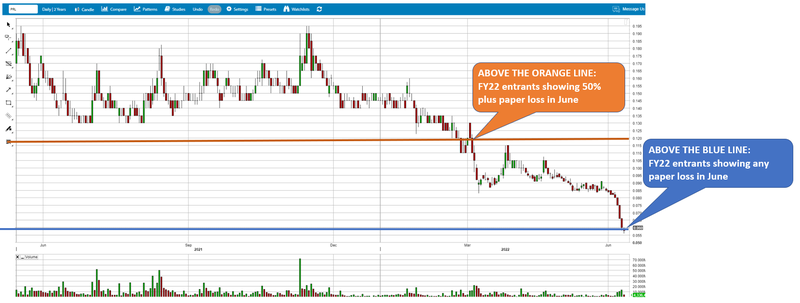
VUL - expected tax loss selling: VUL is also trading at 12 months lows after lithium stocks all came off following a Goldman Sachs report called the end of the lithium price run:
VUL share price over the last financial year
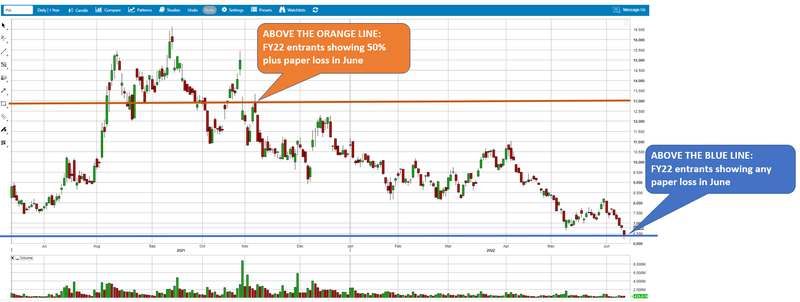
ONE - expected tax loss selling: ONE also has hit 12 month lows in June, despite raising $20M and delivering multiple deals. It has probably been caught up in the broader tech sell off too:
ONE share price over the last financial year
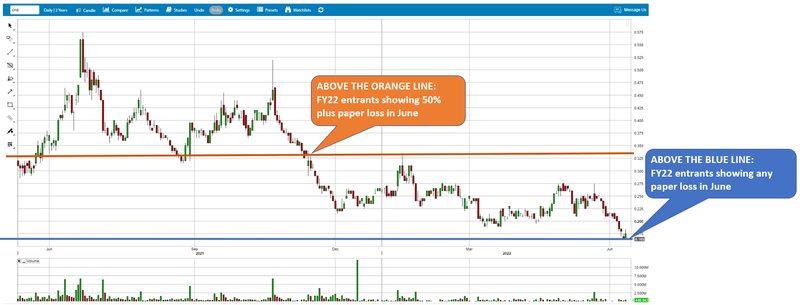
MNB - minimal tax loss selling: MNB has been a great performer this year so no new FY22 investors are sitting at more than a 50% paper loss right now. We think it’s unlikely there will be much tax loss selling:
MNB share price over the last financial year
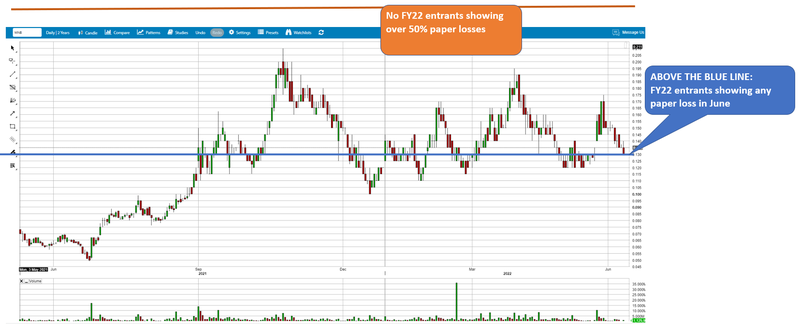
IVZ - minimal tax loss selling: IVZ has been looking very strong all year... until the recent PRM and GLV drill result reminded everyone that oil & gas explorers CAN in fact go down on a bad result, and hard. But it appears to have been a temporary blip and wasn’t enough to encourage tax loss sellers:
IVZ share price over the last financial year
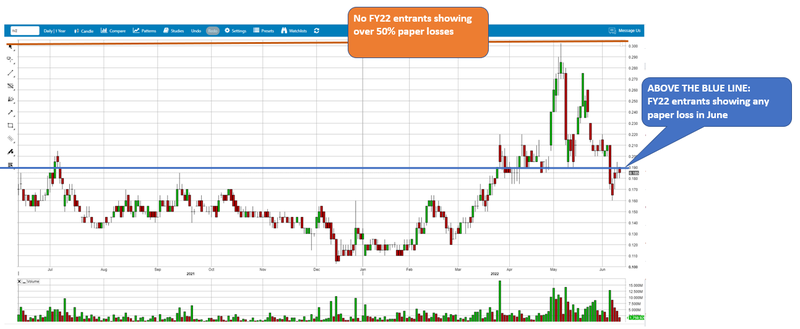
In summary
It is painful to see paper losses in a negative market get compounded by tax loss selling.
Our strategy is to hold long term positions in stocks we believe in, document the reasons why we hold in our Investment Memo, and patiently wait and track progress while the company executes its objectives.
We hope that the true value of a company will be revealed in the average stock price over time trending upwards as the company adds value...
... and we hope to hit a couple of outsized winners.
We try to ride out the short term fluctuations as they happen.
While there are a lot of sellers at the moment, there is always a buyer on the other end of each sell.
Only 13 more trading days till July...
In the meantime, here are the short term key catalysts that we are tracking across our current portfolio companies:
⏲️ Upcoming potential share price catalysts list
Results Delivered:
- The Sasanof companies’ (PRM & GLV) high impact gas drilling event: one of the biggest oil and gas wells drilled in Australia by an ASX junior in decades (memo).
- Drilling of the Sasanof-1 well completed.
- RESULT: FAIL: This was a swing and a miss - the companies announced that “no commercial hydrocarbons were encountered” and both share prices plunged ~80%. You can read our full analysis of the result and execution (or lack thereof) of our investment plan here.
Results expected in the near term:
- GGE is drilling its maiden helium well in Utah where it’s aiming to make a commercial helium discovery (memo).
- IN PROGRESS: GGE has completed its maiden drilling program with a ~203 foot (~62 metre) gas bearing column intercepted. Workover rig being procured to flow test the well.
- Update: No updates this week on the workover rig, we expect to see some news out on this over the next 1-2 weeks.
- PRL signing a Joint Development Agreement with its partner, Total Eren to materially de-risk its WA Green Hydrogen Project (memo)
- IN PROGRESS: The signing of the “Joint development agreement” (JDA) with TotalEnergies. PRL’s deadline to sign the JDA is now set at 31 July 2022.
- Update: No updates on this front this week.
- IVZ is about to drill its giant gas prospect in Zimbabwe - we have been waiting two years for this event (memo).
- IN PROGRESS: Drilling is scheduled for July and IVZ recently updated the market saying it had three separate farm-in offers that were being considered.
- Update: This week IVZ announced that rig mobilisation works had commenced, we covered where IVZ is with a note on Wednesday which you can read here.
- KNI is about to drill its cobalt targets in Norway (memo).
- IN PROGRESS: Last week KNI put out an update on the drilling program confirming that it has completed ~1,007 metres of the total ~2,800m drilling planned. We covered the update in a Quick Take which you can read here.
- Update: No update on this front this week.
- BPM is about to drill its lead zinc prospect in the Earaheedy Basin close to Rumble Resources’ recent discovery (memo)
- IN PROGRESS: BPM is currently completing a ~7,500m AC/RC drilling program at its Hawkins project (along strike from Rumble’s discovery). This is the exploration program we have been waiting for since May last year and we are hoping to start seeing the preliminary results from this over the coming weeks.
- Update: This week BPM announced that the drilling program had to be paused due to extreme unseasonal rain in the Pilbara, we covered this delay in a Quick Take which you can read here.
- LNR (formerly FNT) commencing drilling for rare earths (memo)
- IN PROGRESS: LNR is still in the process of getting approvals, so we are not sure exactly when the actual drilling will occur - this may be later than most of the above list but we are keeping an eye on progress.
- Update: No progress has been made this week.
🗣️ Quick Takes
Here are this week's Quick Takes:
BPM: Assays received from nickel targeted drilling program
BPM: Wet weather timetable in the Earaheedy Basin
DXB: DXB presenting at a US biotech conference in California.
GAL: AFR says Fund managers tipping GAL as IGO’s next takeover target
GAL: More drilling has started at the new Castillo discovery
GTR: US uranium producers to step up and replace Russian supply?
IRD: New iron ore research underlines investment potential of flagship
LNR: 3D Models reveal carbonatite REE Targets
LNR: Heritage surveys delayed to the second half of June
TG1: IP anomalies right under high grade copper rock chips
TG1: New gold project acquisition completed
TMR: Geochemical sampling highlights two gold/copper anomalous zones
TTM: Promising sampling at Linderos copper/ gold project
VN8: Agreement with CBA’s strategic telecoms partner
📰 This week on Next Investors
Invictus Energy (ASX:IVZ)
This week our 2020 Energy Pick of the Year Invictus Energy (ASX:IVZ) took another step towards drilling the largest seismically defined, undrilled gas structure in onshore Africa.
IVZ announced that mobilisation of the Exalo 202 drill rig had started moving from Tanzania to its project in the Cabora Bassa Basin in Zimbabwe.
IVZ expects all equipment to arrive on site in Zimbabwe over the course of June, ahead of the planned two well drilling program.
With gas prices soaring all across the world and the EU on the brink of a full blown gas supply crisis, IVZ now expects drilling at its Mukuyu-1 prospect to commence in July.
The drilling program will target a prospective resource of 9.25 tcf gas + 294 million barrels of Conventional Gas-Condensate (on a 100% gross basis).
Drilling success could result in a regionally significant gas discovery — one big enough to build an entirely new oil and gas industry in Zimbabwe, and supply gas hungry South Africa.
If IVZ successfully makes a new discovery, we could see the company re-rate to many multiples of its current value. Speculators might come in pre drill, which will cause the share price to move upwards before drilling begins.
At the same time, this is a high risk exploration stock. There is always the possibility that the drill won’t be successful; in this case we could see IVZ’s share price move significantly lower.
📰 Read our full Note: IVZ’s Drill Rig Now on its Way - Elephant Scale Gas Target to be Pierced in July
88 Energy (ASX: 88E)
It's been two months since our oil exploration investment 88 Energy (ASX:88E) completed its most recent oil drilling event on the North Slope of Alaska.
88E’s Merlin-2 well was targeting 652 million barrels (mean, unrisked, prospective). Unfortunately probabilities prevailed here and the exploration gods did not hand 88E a commercial discovery at Project Peregrine’s Merlin-2.
Following the failure at the Merlin-2 well, we think most of the focus for 88E this year will be on its “Project Icewine”.
88E’s Project Icewine comprises ~193,000 (net) acres and sits adjacent to UK listed Pantheon Resources projects.
Pantheon Resources is currently capped at A$1.38 billion, having risen from ~ £0.14 in May 2020 to as high as £1.50, an almost 1,000% increase.
Pantheon’s 10-bagger share price run is due to its Alaskan exploration success — right next door to 88E.
Three different wells (Alkaid-1, Talitha-A and Theta West-1) all flowed high quality, light oil, with flow rates between 57 and 108 barrels of oil per day.
Pantheon believes it has a world class discovery on its hands. And given the company’s valuation, the market seems to think it’s got something of value here too.
Pantheon is going to run its first commercial, long term production test next month. It believes that by drilling a horizontal development well at one of the three targets, there’s potential to achieve a 1,600 to 2,200 barrels of oil per day production rate.
In our note on Thursday, we launched our new 88E Investment Memo, where we detail what we want to see the company achieve over the next 12 months with a specific focus on Project Icewine. To see that Memo click here.
📰 Read our full Note: 88E - What to watch out for in the next 12 months
📰 In our other portfolios 🧬 🦉 🏹
🏹 Catalyst Hunter
Latin Resources (ASX: LRS)
Over a wild couple of weeks from mid-March, LRS went from ~4 cents per share to a high of 22.7 cents per share in early April. To capitalise on this opportunity, LRS raised $35M at 16 cents per share in April.
The fresh funds came from institutional investors, anchored by Canadian cornerstone investor, the Electrification and Decarbonization AIE LP Fund.
The funds will be deployed to aggressively drill out a JORC resource at LRS’s Brazilian lithium discovery.
The LRS team has been busy doing resource definition drilling and additional drilling at newly acquired tenements (which look promising and could add to the eventual resource).
We expect a JORC resource to be defined towards the end of this year, which we think will be the next major catalyst to re-rate LRS.
We also compared LRS’s journey to that of Sigma Lithium, its ~US$1.7B market capped lithium peer located ~100kms to the South of LRS’s lithium discovery in Brazil.
This week we re-launched our LRS Investment Memo after their $35M capital raise and altered the Memo to reflect lithium as the company’s main focus.
You can catch our brand new LRS Investment Memo here.
📰 Read our latest full Note: $35M Raised. 4 Drill Rigs. 25,000m of Drilling. LRS Going After Lithium.
Prominence Energy (ASX: PRM) & Global Oil and Gas (ASX: GLV).
On Monday, our nine week wait came to an end after drilling results from our gas exploration Investments’ Prominence Energy (ASX: PRM) and Global Oil and Gas (ASX: GLV) Sasanof-1 well came in.
Unfortunately, “no commercial hydrocarbons were detected”. Words that seasoned investors in high risk oil & gas exploration don’t want to hear, but should be fully expecting and prepared for.
Oil & gas exploration is one of the fastest, but riskiest, ways for investors to seek 1,000% plus gains.
On the rare occasion an exceptional drill result is delivered it can be one of the best days an exploration speculator can get.
However, most attempts will be like it was for PRM and GLV — not much fun at all.
In our note on Monday, we detailed:
- What we learnt from this Investment?
- Would we do it this way again?
- What we are doing now that a negative result has come in.
We also touched on the “Capitulation and Despair Phases” of Investing in micro cap stocks and how after events like this they can transition to becoming “ASX listed shells”.
📰 Read our full Monday Note: “No commercial hydrocarbons were detected” - so what happens now?
🧬Finfeed
Dimerix (ASX:DXB)
We’ve added a new Objective to our DXB Investment Memo and the milestones DXB has to knock down to achieve this new Objective.
The new big shiny Objective for DXB is to complete a clinical trial for Diabetic Kidney Disease (DKD).
DKD is a big market, estimated to be worth US$2.49 billion in 2021 and growing to US$3.34 billion by 2028 as demographics change.
Diabetes impacts kidney function over time, sometimes needing a transplant and transplants in the US cost around US$442,000 to get.
DXB has an agreement with Australian Centre for Accelerating Diabetes Innovation (ACADI) to commence a clinical trial on diabetic kidney disease (expected to commence Q4 this year).
DXB did not outline the funding breakdown for this trial, although reading between the lines, we expect ACADI to contribute to some of the cost of the trial.
This is effectively a second “Main Bet” for the company in addition to the existing “Main Bet” for the company, which is the FSGS Phase 3 trial.
You can catch our updated DXB Investment Memo here.
And of course, the full breakdown in our latest DXB note below.
📰 Read our full Note: Potential new use of DXB’s drug in US$2.5 Billion market
Have a great weekend,
Next Investors
General Information Only
This material has been prepared by StocksDigital. StocksDigital is an authorised representative (CAR 000433913) of 62 Consulting Pty Limited (ABN 88 664 809 303) (AFSL 548573).
This material is general advice only and is not an offer for the purchase or sale of any financial product or service. The material is not intended to provide you with personal financial or tax advice and does not take into account your personal objectives, financial situation or needs. Although we believe that the material is correct, no warranty of accuracy, reliability or completeness is given, except for liability under statute which cannot be excluded. Please note that past performance may not be indicative of future performance and that no guarantee of performance, the return of capital or a particular rate of return is given by 62C, StocksDigital, any of their related body corporates or any other person. To the maximum extent possible, 62C, StocksDigital, their related body corporates or any other person do not accept any liability for any statement in this material.
Conflicts of Interest Notice
S3 and its associated entities may hold investments in companies featured in its articles, including through being paid in the securities of the companies we provide commentary on. We disclose the securities held in relation to a particular company that we provide commentary on. Refer to our Disclosure Policy for information on our self-imposed trading blackouts, hold conditions and de-risking (sell conditions) which seek to mitigate against any potential conflicts of interest.
Publication Notice and Disclaimer
The information contained in this article is current as at the publication date. At the time of publishing, the information contained in this article is based on sources which are available in the public domain that we consider to be reliable, and our own analysis of those sources. The views of the author may not reflect the views of the AFSL holder. Any decision by you to purchase securities in the companies featured in this article should be done so after you have sought your own independent professional advice regarding this information and made your own inquiries as to the validity of any information in this article.
Any forward-looking statements contained in this article are not guarantees or predictions of future performance, and involve known and unknown risks, uncertainties and other factors, many of which are beyond our control, and which may cause actual results or performance of companies featured to differ materially from those expressed in the statements contained in this article. S3 cannot and does not give any assurance that the results or performance expressed or implied by any forward-looking statements contained in this article will actually occur and readers are cautioned not to put undue reliance on forward-looking statements.
This article may include references to our past investing performance. Past performance is not a reliable indicator of our future investing performance.

